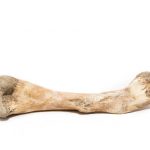 The mineralized connective tissue that constitutes the majority of the skeleton. It consists of an inorganic component (67%) (minerals such as calcium phosphate) and an organic component (33%) (collagenous matrix and cells).
The mineralized connective tissue that constitutes the majority of the skeleton. It consists of an inorganic component (67%) (minerals such as calcium phosphate) and an organic component (33%) (collagenous matrix and cells).
The hard form of connective tissue that constitutes most of the skeleton in most vertebrates.
Calcified connective tissue.
One of the calcified pieces of connective tissue which make the skeleton.
The living tissue that makes up the skeleton. Bone is a form of connective tissue (tissue that supports or holds structures of the body together) that is uniquely hard and strong because of a high concentration of the mineral calcium.
The hard extremely dense connective tissue that forms the skeleton of the body. It is composed of a matrix of collagen fibers impregnated with bone salts (chiefly calcium carbonate and calcium phosphate). Compact bone forms the outer shell of bones; it consists of a hard virtually solid mass made up of bony tissue arranged in concentric layers (Haversian systems). Spongy bone, found beneath compact bone, consists of a meshwork of bony bars (trabeculae) with many interconnecting spaces containing marrow.
The framework upon which the rest of the body is built up. The bones are generally called the skeleton, though this term also includes the cartilages which join the ribs to the breastbone, protect the larynx, etc.
Osseous tissue, a specialized form of dense connective tissue consisting of bone cells (osteocytes) embedded in a nonliving matrix. Bone matrix is made of calcium carbonate, calcium phosphate, and collagen fibers.
The mineral content of bones can vary significantly, constituting anywhere from 20 to 70 percent of the bone’s composition. Additionally, bones possess a significant amount of gelatin-producing material, such as cartilage, which can account for 15 to 50 percent of the bone’s overall structure. Bones also contain a notable quantity of water, ranging from 5 to 50 percent, as well as a percentage of fat, which typically falls between ½ to 20 percent of the bone’s composition.
The skeletal system encompasses the structural substance that offers a sturdy framework for the muscles and safeguards specific organs within the body. When combined with the joints and muscles, the bones constitute the locomotor system, facilitating movement and mobility.
Bone is a complex structure comprised of multiple layers. Its outermost layer, known as the periosteum, forms a delicate covering containing an intricate network of blood vessels and nerves. Situated beneath the periosteum lies the inner shell of solid bone, referred to as hard, compact, or cortical bone. This region consists of columns of bone cells, namely osteoclasts and osteoblasts. Each column possesses a central hollow space called the haversian canal, which plays a vital role in the nourishment, growth, and mending of the bone. The orientation of these haversian canals aligns with the mechanical forces exerted upon the bone.
Within the solid outer shell of bone, there exists a central mesh-like arrangement, often referred to as spongy, cancellous, or trabecular bone. This inner structure provides resilience and flexibility. Moreover, certain bones possess a hollow cavity at their core, while the spaces within spongy bone house the bone marrow. It is within this bone marrow that the production of red blood cells, platelets, and the majority of white blood cells takes place.
The dynamic process of bone remodeling involves the continuous reabsorption of bone by osteoclasts, followed by its replacement through the activity of osteoblasts. Osteoblasts play a pivotal role in promoting the deposition of calcium phosphate onto the protein framework of the bone, whereas osteoclasts are responsible for removing it. The actions of these specialized cells are under the control of various hormones, including growth hormone secreted by the pituitary gland, as well as the sex hormones estrogen and testosterone, adrenal hormones, thyrocalcitonin produced by the thyroid gland, and parathyroid hormone. Additionally, these hormones work in concert to regulate and maintain the appropriate levels of calcium in the bloodstream.
The development of most bones initiates during the fifth or sixth week of pregnancy within the embryo, initially taking the form of cartilage. Around the seventh or eighth week of pregnancy, this cartilage begins to undergo a transformation known as ossification, wherein it gradually gets replaced by solid bone. However, this ossification process is not fully completed until early adulthood. At birth, numerous bones primarily consist of cartilage, which later ossifies as an individual matures. The growing ends of long bones, referred to as epiphyses, remain separated from the bone shaft, known as the diaphysis, by the presence of the epiphyseal plate. It is worth noting that certain bones in the body, such as specific skull bones, do not originate from cartilage but instead develop as membranous bones.